You [Gerald Bauer¹] have been permanently banned [for life] from participating in r/ruby (because of your writing off / outside of r/ruby). I do not see your participation adding anything to this [ruby] community.
-- Richard Schneeman (r/ruby mod and fanatic illiberal ultra leftie on a cancel culture mission)
¹: I know. Who cares? Who is this Gerald Bauer anyway. A random nobody for sure. It just happens that I am the admin among other things of Planet Ruby.
Case Studies of Code of Conduct "Cancel Culture" Out-Of-Control Power Abuse - Ruby - A Call for Tolerance On Ruby-Talk Results In Ban On Reddit RubyUpdate (August, 2022) - A Call for More Tolerance And Call For No-Ban Policy Results In Ban On Ruby-Talk (With No Reason Given)
> I just banned gerald.bauer@gmail.com. > > -- SHIBATA Hiroshi > >> THANK YOU >> >> -- Ryan Davis >> >> >> My full support to moderators. >> >> -- Xavier Noria >> >> My full support to moderators. >> >> -- Carlo E. Prelz >> >> That's fun. >> >> -- Alice
« Ruby Glimmer Days 2021, January 26th to January 29th - 4 Days of Ruby (Desktop) Gems
Day 5 - glimmer_tetris Gem - Glimmer Tetris - The Playfield - Get Tetris Working in One Day!
Written by Andy Maleh
Software Engineering Expert from Montreal, Quebec. Creator of Glimmer and Abstract Feature Branch. Speaker at RailsConf, RubyConf, AgileConf, EclipseCon, EclipseWorld. Master in Software Engineering, DePaul University, Chicago. Blogs at Code Mastery Takes Commitment To Bold Coding Adventures. Snowboarder and Drummer.
Goal
Use Glimmer DSL for SWT in JRuby to build the classic Tetris game for desktop computers, beginning with The Playfield that drops Tetromino blocks downward and receives user input for Tetromino movement direction and rotation.
Pre-requisites
Make sure you first meet all the pre-requisites of Glimmer DSL for SWT v4.20.0.0
Mainly, Java (specified version), JRuby (specified version), and Git (and RVM on Mac/Linux)
Setup
Open a terminal screen and install the glimmer-dsl-swt gem with JRuby’s jgem command (similar to Ruby’s gem command).
jgem install glimmer-dsl-swt -v4.20.0.0
On the Mac, additionally run glimmer-setup:
glimmer-setup
Scaffolding
Glimmer DSL for SWT offers a command for scaffolding a simple Glimmer desktop application from scratch, starting by installing the required project gems (scoping by a separate gemset if you are using RVM), moving on to generating the project MVC-friendly directory structure and files, and ending with native executable packaging to be able to release from the get-go (e.g. generating native APP, DMG, PKG files on the Mac).
On the Mac and Linux, you can simply run glimmer to get a TUI and choose the scaffold[app_name] option, then enter the name of the app as “glimmer-tetris”
This is how it looks like:
Glimmer (JRuby Desktop Development GUI Framework) - JRuby Gem: glimmer-dsl-swt v4.20.0.0
Usage: glimmer [--bundler] [--pd] [--quiet] [--debug] [--log-level=VALUE] [[ENV_VAR=VALUE]...] [[-jruby-option]...] (application.rb or task[task_args]) [[application2.rb]...]
Runs Glimmer applications and tasks.
When applications are specified, they are run using JRuby,
automatically preloading the glimmer Ruby gem and SWT jar dependency.
Optionally, extra Glimmer options, JRuby options, and/or environment variables may be passed in.
Glimmer options:
- "--bundler=GROUP" : Activates gems in Bundler default group in Gemfile
- "--pd=BOOLEAN" : Requires puts_debuggerer to enable pd method
- "--quiet=BOOLEAN" : Does not announce file path of Glimmer application being launched
- "--debug" : Displays extra debugging information, passes "--debug" to JRuby, and enables debug logging
- "--log-level=VALUE" : Sets Glimmer's Ruby logger level ("ERROR" / "WARN" / "INFO" / "DEBUG"; default is none)
Tasks are run via rake. Some tasks take arguments in square brackets.
Available tasks are below (if you do not see any, please add `require 'glimmer/rake_task'` to Rakefile and rerun or run rake -T):
Select a Glimmer task to run: (Press ↑/↓ arrow to move, Enter to select and letters to filter)
glimmer list:gems:customshape[query] # List Glimmer custom shape gems available at rubygems.org (query is optional) [alt: list:gems:cp]
‣ glimmer list:gems:customshell[query] # List Glimmer custom shell gems available at rubygems.org (query is optional) [alt: list:gems:cs]
glimmer list:gems:customwidget[query] # List Glimmer custom widget gems available at rubygems.org (query is optional) [alt: list:gems:cw]
glimmer list:gems:dsl[query] # List Glimmer DSL gems available at rubygems.org (query is optional)
glimmer package[type] # Package app for distribution (generating config, jar, and native files) (type is optional)
glimmer package:clean # Clean by removing "dist" and "packages" directories
glimmer package:config # Generate JAR config file
glimmer package:gem # Generate gem under pkg directory
glimmer package:gemspec # Generate gemspec
glimmer package:jar # Generate JAR file
glimmer package:lock_jars # Lock JARs
glimmer package:native[type] # Generate Native files
glimmer run[app_path] # Runs Glimmer app or custom shell gem in the current directory, unless app_path is specified, then runs it instead (app_path is optional)
glimmer samples # Brings up the Glimmer Meta-Sample app to allow browsing, running, and viewing code of Glimmer samples
glimmer scaffold[app_name] # Scaffold Glimmer application directory structure to build a new app
glimmer scaffold:customshape[name,namespace] # Scaffold Glimmer::UI::CustomShape subclass (part of a view) under app/views (namespace is optional) [alt: scaffold:cp]
glimmer scaffold:customshell[name,namespace] # Scaffold Glimmer::UI::CustomShell subclass (full window view) under app/views (namespace is optional) [alt: scaffold:cs]
glimmer scaffold:customwidget[name,namespace] # Scaffold Glimmer::UI::CustomWidget subclass (part of a view) under app/views (namespace is optional) [alt: scaffold:cw]
glimmer scaffold:desktopify[app_name,website] # Desktopify a web app
glimmer scaffold:gem:customshape[name,namespace] # Scaffold Glimmer::UI::CustomShape subclass (part of a view) under its own Ruby gem project (namespace is required) [alt: scaffold:gem:cp]
glimmer scaffold:gem:customshell[name,namespace] # Scaffold Glimmer::UI::CustomShell subclass (full window view) under its own Ruby gem + app project (namespace is required) [alt: scaffold:ge...
glimmer scaffold:gem:customwidget[name,namespace] # Scaffold Glimmer::UI::CustomWidget subclass (part of a view) under its own Ruby gem project (namespace is required) [alt: scaffold:gem:cw]
On Windows, run:
glimmer scaffold[glimmer_tetris]
(also works on the Mac/Linux as an alternative, but with double-quotes around the option in ZShell: glimmer "scaffold[glimmer_tetris]")
At the end of the scaffolding process, you should see a Hello, World! application launch
(you might see an error message too Exec failed with code 2 command, but ignore it.)

You may checkout the app menu bar, open preferences and attempt to update the message from “Hello, World!” to “Howdy, Partner!” to confirm it is working.

Game Rules
I would assume everyone has played Tetris at this point. I played it mostly more than 20 years ago during the Gameboy original era.
The rules of the game go something like this:
- A new Tetromino starts moving downwards into The Playfield from the top, about a block a second.
- The Tetromino stops once it hits the bottom of The Playfield at which point a new Tetromino starts moving downwards from the top again.
- The player can move the Tetromino right and left with the keyboard arrow keys to better organize and consume empty space in The Playfield.
- The player can rotate (turn) the Tetromino right and left with the keyboard shift keys.
- The player can optionally move the Tetromino faster downwards by hitting the keyboard down arrow key
- The player eliminates a line of Tetromino blocks once forming a line at the bottom of The Playfield. The goal is to form as many of such lines as possible.
- the player accumulates more and more Tetrominos till they max out The Playfield height at which point it’s Game Over.
Software Architecture
Glimmer applications generally follow the MVC (Model-View-Controller) architectural pattern or one of its variations: MVP (Model-View-Presenter) & MVVM (Model-View-ViewModel).
The Model layer is beyond the scope of this article series. As such, Model code will be provided.
(Also, I am no game development expert, yet more of a business app developer, so I am sure others could come up with much smarter Tetris block collision detection algorithms that are proven free of errors. Still, what I provide works well enough after iterating on it for a little less than a week, so model bugs would not surprise me, but are besides the point of the article)
Now, let’s jump to the exciting part that Glimmer DSL for SWT is used for: the View!.
The Tetris Playfield is simply 10x20 of Blocks, which can accomodate shapes that are called Tetrominos.
Here is a screenshot of the final Tetris screen we want to achieve over the course of this article series:

Here is a screenshot of The Playfield we want to achieve at the end of this article:
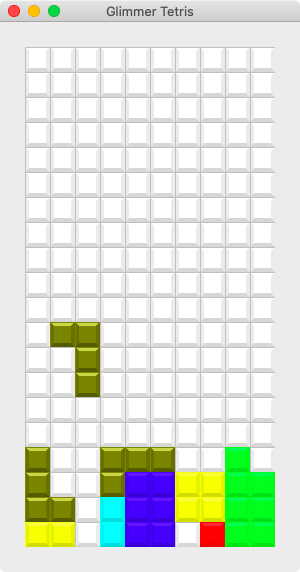
The dimensions are 10x20:
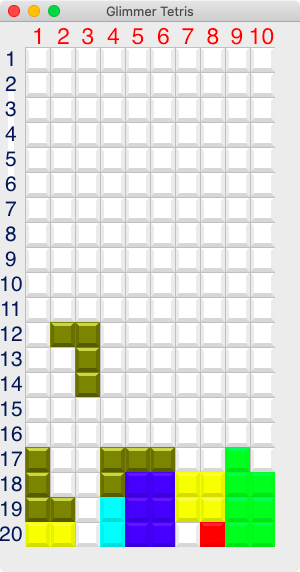
There are various ways to solve the Tetris moving Tetromino problem, such as:
- Imperatively paint the state of Playfield Blocks (e.g. colors) and the entire View upon every system event change (passing of a second to move a Tetromino down) and user-input event (e.g. keyboard press)
- Paint a static board/container and then continuously calculate the x/y positions of Tetrominos and their colors upon every system event/user-input-event change and move them along the static board by rerendering the clipped/changed areas only
- Declaratively Data-Bind View blocks to Model blocks and let the Models do all the calculations, automatically reflecting changes (e.g. colors) in the View with the Observer Pattern, which only updates changed parts without any extra View code like direct Render/Move calls
I am sure you guessed which approach we will go with. It is most certainly number 3. It yields very compact View code that is highly readable, reliable, and maintainable. Additionally, it enables all the Tetris calculation code to be highly testable with automated model tests should that be desired for extra assurance of correctness.
Another way to explain the solution is to model the Tetris game playfield as simply 10x20 model Blocks and map them to 10x20 view Blocks in terms of color. Now, the Model layer can take over doing all the calculations of Tetromino movement as it receives system events (e.g. one second passed) and user input (e.g. move right) from the View, and then once calculations make changes in the Model layer, they get automatically reflected in the View layer, thanks to Glimmer data-binding and the Observer Pattern. This results in a very slim View layer that barely has any code, which might actually be the cleanest Tetris GUI implementation on Earth.
Let’s find out next what this means in practice.
Model Layer
The Models Layer explanation is outside the scope of this article, so the Models are simply supplied below.
Save them under the right paths mentioned inside the scaffolded “glimmer_tetris” app.
Block
This represents a block in The Playfield or in a Tetromino.
Path: app/glimmer_tetris/model/block.rb
Code:
class GlimmerTetris
module Model
class Block
COLOR_CLEAR = :white
attr_accessor :color
# Initializes with color. Default color (gray) signifies an empty block
def initialize(color = COLOR_CLEAR)
@color = color
end
# Clears block color. `quietly` option indicates if it should not notify observers by setting value quietly via variable not attribute writer.
def clear
self.color = COLOR_CLEAR unless self.color == COLOR_CLEAR
end
def clear?
self.color == COLOR_CLEAR
end
def occupied?
!clear?
end
end
end
end
Tetromino
This represents a Tetromino shape, which can be one of the following letters:
I

J
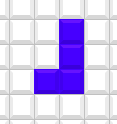
L

O

S
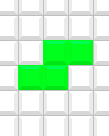
T
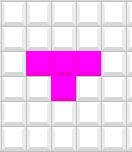
Z
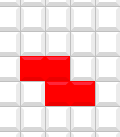
It is mainly responsible for collision detection and tracking the state of Tetrominos in The Playfield.
Path: app/glimmer_tetris/model/tetromino.rb
Code:
require 'matrix'
require_relative 'block'
class GlimmerTetris
module Model
class Tetromino
ORIENTATIONS = [:north, :east, :south, :west]
LETTER_COLORS = {
I: :cyan,
J: :blue,
L: :dark_yellow,
O: :yellow,
S: :green,
T: :magenta,
Z: :red,
}
attr_reader :game, :letter, :preview
alias preview? preview
attr_accessor :orientation, :blocks, :row, :column
def initialize(game)
@game = game
@letter = LETTER_COLORS.keys.sample
@orientation = :north
@blocks = default_blocks
@preview = true
new_row = 0
new_column = (Model::Game::PREVIEW_PLAYFIELD_WIDTH - width)/2
update_playfield(new_row, new_column)
end
def playfield
@preview ? game.preview_playfield : game.playfield
end
def launch!
remove_from_playfield
@preview = false
new_row = 1 - height
new_column = (game.playfield_width - width)/2
update_playfield(new_row, new_column)
game.tetrominoes << self
end
def update_playfield(new_row = nil, new_column = nil)
remove_from_playfield
if !new_row.nil? && !new_column.nil?
@row = new_row
@column = new_column
add_to_playfield
end
end
def add_to_playfield
update_playfield_block do |playfield_row, playfield_column, row_index, column_index|
playfield[playfield_row][playfield_column].color = blocks[row_index][column_index].color if playfield_row >= 0 && playfield[playfield_row][playfield_column]&.clear? && !blocks[row_index][column_index].clear? && playfield[playfield_row][playfield_column].color != blocks[row_index][column_index].color
end
end
def remove_from_playfield
return if @row.nil? || @column.nil?
update_playfield_block do |playfield_row, playfield_column, row_index, column_index|
playfield[playfield_row][playfield_column].clear if playfield_row >= 0 && !blocks[row_index][column_index].clear? && playfield[playfield_row][playfield_column]&.color == color
end
end
def stopped?
return true if @stopped || @preview
playfield_remaining_heights = game.playfield_remaining_heights(self)
result = bottom_most_blocks.any? do |bottom_most_block|
playfield_column = @column + bottom_most_block[:column_index]
playfield_remaining_heights[playfield_column] &&
@row + bottom_most_block[:row_index] >= playfield_remaining_heights[playfield_column] - 1
end
if result && !game.hypothetical?
@stopped = result
game.consider_eliminating_lines
@game.consider_adding_tetromino
end
result
end
# Returns bottom-most blocks of a tetromino, which could be from multiple rows depending on shape (e.g. T)
def bottom_most_blocks
width.times.map do |column_index|
row_blocks_with_row_index = @blocks.each_with_index.to_a.reverse.detect do |row_blocks, row_index|
!row_blocks[column_index].clear?
end
bottom_most_block = row_blocks_with_row_index[0][column_index]
bottom_most_block_row = row_blocks_with_row_index[1]
{
block: bottom_most_block,
row_index: bottom_most_block_row,
column_index: column_index
}
end
end
def bottom_most_block_for_column(column)
bottom_most_blocks.detect {|bottom_most_block| (@column + bottom_most_block[:column_index]) == column}
end
def right_blocked?
(@column == game.playfield_width - width) ||
right_most_blocks.any? { |right_most_block|
(@row + right_most_block[:row_index]) >= 0 &&
playfield[@row + right_most_block[:row_index]][@column + right_most_block[:column_index] + 1].occupied?
}
end
# Returns right-most blocks of a tetromino, which could be from multiple columns depending on shape (e.g. T)
def right_most_blocks
@blocks.each_with_index.map do |row_blocks, row_index|
column_block_with_column_index = row_blocks.each_with_index.to_a.reverse.detect do |column_block, column_index|
!column_block.clear?
end
if column_block_with_column_index
right_most_block = column_block_with_column_index[0]
{
block: right_most_block,
row_index: row_index,
column_index: column_block_with_column_index[1]
}
end
end.compact
end
def left_blocked?
(@column == 0) ||
left_most_blocks.any? { |left_most_block|
(@row + left_most_block[:row_index]) >= 0 &&
playfield[@row + left_most_block[:row_index]][@column + left_most_block[:column_index] - 1].occupied?
}
end
# Returns right-most blocks of a tetromino, which could be from multiple columns depending on shape (e.g. T)
def left_most_blocks
@blocks.each_with_index.map do |row_blocks, row_index|
column_block_with_column_index = row_blocks.each_with_index.to_a.detect do |column_block, column_index|
!column_block.clear?
end
if column_block_with_column_index
left_most_block = column_block_with_column_index[0]
{
block: left_most_block,
row_index: row_index,
column_index: column_block_with_column_index[1]
}
end
end.compact
end
def width
@blocks[0].size
end
def height
@blocks.size
end
def down!(instant: false)
launch! if preview?
unless stopped?
block_count = 1
if instant
remaining_height, bottom_touching_block = remaining_height_and_bottom_touching_block
block_count = remaining_height - @row
end
new_row = @row + block_count
update_playfield(new_row, @column)
end
end
def left!
unless left_blocked?
new_column = @column - 1
update_playfield(@row, new_column)
end
end
def right!
unless right_blocked?
new_column = @column + 1
update_playfield(@row, new_column)
end
end
# Rotate in specified direcation, which can be :right (clockwise) or :left (counterclockwise)
def rotate!(direction)
return if stopped?
can_rotate = nil
new_blocks = nil
game.hypothetical do
hypothetical_rotated_tetromino = hypothetical_tetromino
new_blocks = hypothetical_rotated_tetromino.rotate_blocks(direction)
can_rotate = !hypothetical_rotated_tetromino.stopped? && !hypothetical_rotated_tetromino.right_blocked? && !hypothetical_rotated_tetromino.left_blocked?
end
if can_rotate
remove_from_playfield
self.orientation = ORIENTATIONS[ORIENTATIONS.rotate(direction == :right ? -1 : 1).index(@orientation)]
self.blocks = new_blocks
update_playfield(@row, @column)
end
rescue => e
puts e.full_message
end
def rotate_blocks(direction)
new_blocks = Matrix[*@blocks].transpose.to_a
if direction == :right
new_blocks = new_blocks.map(&:reverse)
else
new_blocks = new_blocks.reverse
end
Matrix[*new_blocks].to_a
end
def hypothetical_tetromino
clone.tap do |hypo_clone|
remove_from_playfield
hypo_clone.blocks = @blocks.map do |row_blocks|
row_blocks.map do |column_block|
column_block.clone
end
end
end
end
def remaining_height_and_bottom_touching_block
playfield_remaining_heights = game.playfield_remaining_heights(self)
bottom_most_blocks.map do |bottom_most_block|
playfield_column = @column + bottom_most_block[:column_index]
[playfield_remaining_heights[playfield_column] - (bottom_most_block[:row_index] + 1), bottom_most_block]
end.min_by(&:first)
end
def default_blocks
case @letter
when :I
[
[block, block, block, block]
]
when :J
[
[block, block, block],
[empty, empty, block],
]
when :L
[
[block, block, block],
[block, empty, empty],
]
when :O
[
[block, block],
[block, block],
]
when :S
[
[empty, block, block],
[block, block, empty],
]
when :T
[
[block, block, block],
[empty, block, empty],
]
when :Z
[
[block, block, empty],
[empty, block, block],
]
end
end
def color
LETTER_COLORS[@letter]
end
def include_block?(block)
@blocks.flatten.include?(block)
end
private
def block
Block.new(color)
end
def empty
Block.new
end
def update_playfield_block(&updater)
@row.upto(@row + height - 1) do |playfield_row|
@column.upto(@column + width - 1) do |playfield_column|
row_index = playfield_row - @row
column_index = playfield_column - @column
updater.call(playfield_row, playfield_column, row_index, column_index)
end
end
end
end
end
end
Game
This represents the entire game, including The Playfield (though The Playfield could be a good thing to extract as a class outside this article).
Path: app/glimmer_tetris/model/game.rb
Code:
require 'fileutils'
require 'json'
require 'glimmer/data_binding/observer'
require 'glimmer/config'
require_relative 'block'
require_relative 'tetromino'
require_relative 'past_game'
class GlimmerTetris
module Model
class Game
PLAYFIELD_WIDTH = 10
PLAYFIELD_HEIGHT = 20
PREVIEW_PLAYFIELD_WIDTH = 4
PREVIEW_PLAYFIELD_HEIGHT = 2
SCORE_MULTIPLIER = {1 => 40, 2 => 100, 3 => 300, 4 => 1200}
attr_reader :playfield_width, :playfield_height
attr_accessor :game_over, :paused, :preview_tetromino, :lines, :score, :level, :high_scores, :beeping, :added_high_score, :show_high_scores, :up_arrow_action
alias game_over? game_over
alias paused? paused
alias beeping? beeping
alias added_high_score? added_high_score
def initialize(playfield_width = PLAYFIELD_WIDTH, playfield_height = PLAYFIELD_HEIGHT)
@playfield_width = playfield_width
@playfield_height = playfield_height
@high_scores = []
@show_high_scores = false
@beeping = true
@up_arrow_action = :rotate_left
load_high_scores!
end
def configure_beeper(&beeper)
@beeper = beeper
end
def game_in_progress?
!game_over? && !paused?
end
def start!
self.show_high_scores = false
self.paused = false
self.level = 1
self.score = 0
self.lines = 0
reset_playfield
reset_preview_playfield
reset_tetrominoes
preview_next_tetromino!
consider_adding_tetromino
self.game_over = false
end
alias restart! start!
def game_over!
add_high_score!
beep
self.game_over = true
end
def clear_high_scores!
high_scores.clear
end
def add_high_score!
self.added_high_score = true
high_scores.prepend(PastGame.new("Player #{high_scores.count + 1}", score, lines, level))
end
def save_high_scores!
high_score_file_content = @high_scores.map {|past_game| past_game.to_a.join("\t") }.join("\n")
FileUtils.mkdir_p(tetris_dir)
File.write(tetris_high_score_file, high_score_file_content)
rescue => e
# Fail safely by keeping high scores in memory if unable to access disk
Glimmer::Config.logger.error {"Failed to save high scores in: #{tetris_high_score_file}\n#{e.full_message}"}
end
def load_high_scores!
if File.exist?(tetris_high_score_file)
self.high_scores = File.read(tetris_high_score_file).split("\n").map {|line| PastGame.new(*line.split("\t")) }
end
rescue => e
# Fail safely by keeping high scores in memory if unable to access disk
Glimmer::Config.logger.error {"Failed to load high scores from: #{tetris_high_score_file}\n#{e.full_message}"}
end
def tetris_dir
@tetris_dir ||= File.join(File.expand_path('~'), '.glimmer-tetris')
end
def tetris_high_score_file
File.join(tetris_dir, "high_scores.txt")
end
def down!(instant: false)
return unless game_in_progress?
current_tetromino.down!(instant: instant)
game_over! if current_tetromino.row <= 0 && current_tetromino.stopped?
end
def right!
return unless game_in_progress?
current_tetromino.right!
end
def left!
return unless game_in_progress?
current_tetromino.left!
end
def rotate!(direction)
return unless game_in_progress?
current_tetromino.rotate!(direction)
end
def current_tetromino
tetrominoes.last
end
def tetrominoes
@tetrominoes ||= reset_tetrominoes
end
# Returns blocks in the playfield
def playfield
@playfield ||= @original_playfield = @playfield_height.times.map {
@playfield_width.times.map {
Block.new
}
}
end
# Executes a hypothetical scenario without truly changing playfield permanently
def hypothetical(&block)
@playfield = hypothetical_playfield
block.call
@playfield = @original_playfield
end
# Returns whether currently executing a hypothetical scenario
def hypothetical?
@playfield != @original_playfield
end
def hypothetical_playfield
@playfield_height.times.map { |row|
@playfield_width.times.map { |column|
playfield[row][column].clone
}
}
end
def preview_playfield
@preview_playfield ||= PREVIEW_PLAYFIELD_HEIGHT.times.map {|row|
PREVIEW_PLAYFIELD_WIDTH.times.map {|column|
Block.new
}
}
end
def preview_next_tetromino!
self.preview_tetromino = Tetromino.new(self)
end
def calculate_score!(eliminated_lines)
new_score = SCORE_MULTIPLIER[eliminated_lines] * (level + 1)
self.score += new_score
end
def level_up!
self.level += 1 if lines >= self.level*10
end
def delay
[1.1 - (level.to_i * 0.1), 0.001].max
end
def beep
@beeper&.call if beeping
end
def instant_down_on_up=(value)
self.up_arrow_action = :instant_down if value
end
def instant_down_on_up
self.up_arrow_action == :instant_down
end
def rotate_right_on_up=(value)
self.up_arrow_action = :rotate_right if value
end
def rotate_right_on_up
self.up_arrow_action == :rotate_right
end
def rotate_left_on_up=(value)
self.up_arrow_action = :rotate_left if value
end
def rotate_left_on_up
self.up_arrow_action == :rotate_left
end
def reset_tetrominoes
@tetrominoes = []
end
def reset_playfield
playfield.each do |row|
row.each do |block|
block.clear
end
end
end
def reset_preview_playfield
preview_playfield.each do |row|
row.each do |block|
block.clear
end
end
end
def consider_adding_tetromino
if tetrominoes.empty? || current_tetromino.stopped?
preview_tetromino.launch!
preview_next_tetromino!
end
end
def consider_eliminating_lines
eliminated_lines = 0
playfield.each_with_index do |row, playfield_row|
if row.all? {|block| !block.clear?}
eliminated_lines += 1
shift_blocks_down_above_row(playfield_row)
end
end
if eliminated_lines > 0
beep
self.lines += eliminated_lines
level_up!
calculate_score!(eliminated_lines)
end
end
def playfield_remaining_heights(tetromino = nil)
@playfield_width.times.map do |playfield_column|
bottom_most_block = tetromino.bottom_most_block_for_column(playfield_column)
(playfield.each_with_index.detect do |row, playfield_row|
!row[playfield_column].clear? &&
(
tetromino.nil? ||
bottom_most_block.nil? ||
(playfield_row > tetromino.row + bottom_most_block[:row_index])
)
end || [nil, @playfield_height])[1]
end.to_a
end
private
def shift_blocks_down_above_row(row)
row.downto(0) do |playfield_row|
playfield[playfield_row].each_with_index do |block, playfield_column|
previous_row = playfield[playfield_row - 1]
previous_block = previous_row[playfield_column]
block.color = previous_block.color unless block.color == previous_block.color
end
end
playfield[0].each(&:clear)
end
end
end
end
Past Game
This represents past games for the sake of high score record keeping.
Path: app/glimmer_tetris/model/past_game.rb
Code:
class GlimmerTetris
module Model
class PastGame
attr_accessor :name, :score, :lines, :level
def initialize(name, score, lines, level)
@name = name
@score = score.to_i
@lines = lines.to_i
@level = level.to_i
end
def to_a
[@name, @score, @lines, @level]
end
end
end
end
View Layer
If we were to analyze the inputs of the Model layer, there are two types of inputs:
- System events: passing of time moving a Tetromino down
- User input: movement of Tetrominos, pause and restart, etc…
A Glimmer DSL for SWT view can come in one of two ways:
- Shell: represents a window, main or secondary, representing the app entry point in the former case.
- Widget: represents part of a window that renders specific information (e.g. The Playfield or Score Lane)
Both types can be custom made using CustomShell or CustomWidget in Glimmer.
So, to gain entry into the app, we know we need a shell. Thankfully, Glimmer DSL for SWT already scaffolded one for us called AppView
or more specifically GlimmerTetris::View::AppView, which is located in app/glimmer_tetris/view/app_view.rb.
A Custom Shell usually has a required body {}, and optional before_body {} and after_body {} blocks.
The body {} block contains the content of the app, like The Playfield.
The before_body {} block usually sets up general variables (like the models to be data-bound to the views) and general display configuration and shortcuts.
The after_body {} block usually sets up model observers (like monitoring the game for game over status) and updates the views accordingly in cases where updates are one way and bidirectional data-binding is not needed (e.g. show game over screen when observed game is over).
Let us see how all of this plays in practice (pun intended).
GlimmerTetris
The app/glimmer_tetris.rb file contains the GlimmerTetris top-level app namespace class, which contains common constants to be used by all views and/or models.
Please open and add the following extra constants to it at the bottom of the class:
BLOCK_SIZE = 25
FONT_NAME = 'Menlo'
FONT_TITLE_HEIGHT = 32
FONT_TITLE_STYLE = :bold
BEVEL_CONSTANT = 20
It should now look like:
$LOAD_PATH.unshift(File.expand_path('..', __FILE__))
require 'bundler/setup'
Bundler.require(:default)
require 'glimmer_tetris/view/app_view'
class GlimmerTetris
APP_ROOT = File.expand_path('../..', __FILE__)
VERSION = File.read(File.join(APP_ROOT, 'VERSION'))
LICENSE = File.read(File.join(APP_ROOT, 'LICENSE.txt'))
BLOCK_SIZE = 25
FONT_NAME = 'Menlo'
FONT_TITLE_HEIGHT = 32
FONT_TITLE_STYLE = :bold
BEVEL_CONSTANT = 20
end
AppView
Replace the content of app/glimmer_tetris/view/app_view.rb with the following (note that some of the unused variables/constants are in preparation for later parts):
require_relative '../model/game'
class GlimmerTetris
module View
class AppView
include Glimmer::UI::CustomShell
attr_reader :game
before_body {
@mutex = Mutex.new
@game = Model::Game.new
@game.configure_beeper do
display.beep
end
Display.app_name = 'Glimmer Tetris'
display {
on_swt_keydown { |key_event|
case key_event.keyCode
when swt(:arrow_down), 's'.bytes.first
if OS.mac?
game.down!
else
# rate limit downs in Windows/Linux as they go too fast when key is held
@queued_downs ||= 0
@queued_downs += 1
async_exec do
game.down! if @queued_downs < 3
@queued_downs -= 1
end
end
when swt(:arrow_up)
case game.up_arrow_action
when :instant_down
game.down!(instant: true)
when :rotate_right
game.rotate!(:right)
when :rotate_left
game.rotate!(:left)
end
when swt(:arrow_left), 'a'.bytes.first
game.left!
when swt(:arrow_right), 'd'.bytes.first
game.right!
when swt(:shift), swt(:alt)
if key_event.keyLocation == swt(:right) # right shift key
game.rotate!(:right)
elsif key_event.keyLocation == swt(:left) # left shift key
game.rotate!(:left)
end
end
}
# if running in app mode, set the Mac app about dialog (ignored in platforms)
on_about {
show_about_dialog
}
on_quit {
exit(0)
}
}
}
after_body {
@game_over_observer = observe(@game, :game_over) do |game_over|
if game_over
show_game_over_message_box
else
start_moving_tetrominos_down
end
end
@game.start!
}
body {
shell(:no_resize) {
grid_layout
text 'Glimmer Tetris'
composite((:double_buffered unless OS.mac?)) {
grid_layout {
num_columns Model::Game::PLAYFIELD_WIDTH
make_columns_equal_width true
margin_width BLOCK_SIZE
margin_height BLOCK_SIZE
horizontal_spacing 0
vertical_spacing 0
}
Model::Game::PLAYFIELD_HEIGHT.times do |row|
Model::Game::PLAYFIELD_WIDTH.times do |column|
composite {
layout_data {
width_hint BLOCK_SIZE
height_hint BLOCK_SIZE
}
background bind(@game.playfield[row][column], :color)
}
end
end
}
}
}
def start_moving_tetrominos_down
Thread.new do
@mutex.synchronize do
loop do
time = Time.now
sleep @game.delay
break if @game.game_over? || body_root.disposed?
# ensure entire game tetromino down movement happens as one GUI update event with sync_exec (to avoid flicker/stutter)
sync_exec { @game.down! unless @game.paused? }
end
end
end
end
def show_game_over_message_box
message_box {
text 'Game Over'
message 'Play Again?'
}.open # this blocks until closed
@game.start!
end
def show_about_dialog
message_box {
text 'Glimmer Tetris'
message "Glimmer Tetris\n\nGlimmer DSL for SWT Sample\n\nCopyright (c) 2007-2021 Andy Maleh"
}.open
end
end
end
end
Now, go to the game directory in the terminal and run:
glimmer run

AppView body
Notice that the main body {} of code is only 30 lines (and it WORKS)!!!
body {
shell(:no_resize) {
grid_layout
text 'Glimmer Tetris'
composite((:double_buffered unless OS.mac?)) {
grid_layout {
num_columns Model::Game::PLAYFIELD_WIDTH
make_columns_equal_width true
margin_width BLOCK_SIZE
margin_height BLOCK_SIZE
horizontal_spacing 0
vertical_spacing 0
}
Model::Game::PLAYFIELD_HEIGHT.times do |row|
Model::Game::PLAYFIELD_WIDTH.times do |column|
label {
layout_data {
width_hint BLOCK_SIZE
height_hint BLOCK_SIZE
}
background bind(@game.playfield[row][column], :color)
}
end
end
}
}
}
To explain how this version works, we start by laying a composite (with double buffering for improved animation on operating systems other than the nice Mac) to take advantage of the
grid_layout, setting 10 columns on it, and then declaring the blocks (empty labels with a background color) one by one till they fill 20 rows of 10 columns each.
Lastly, we declaratively data-bind the background color of each label to its matching game playfield block for its row and column to get updated automatically upon Block model changes.
It is that simple!
AppView before_body
What makes the game models receive the user’s input though?
Let us decipher the before_body block:
@mutex = Mutex.new
@game = Model::Game.new
@game.configure_beeper do
display.beep
end
Display.app_name = 'Glimmer Tetris'
display {
on_swt_keydown { |key_event|
case key_event.keyCode
when swt(:arrow_down), 's'.bytes.first
game.down! if OS.mac?
when swt(:arrow_up)
case game.up_arrow_action
when :instant_down
game.down!(instant: true)
when :rotate_right
game.rotate!(:right)
when :rotate_left
game.rotate!(:left)
end
when swt(:arrow_left), 'a'.bytes.first
game.left!
when swt(:arrow_right), 'd'.bytes.first
game.right!
when swt(:shift), swt(:alt)
if key_event.keyLocation == swt(:right) # right shift key
game.rotate!(:right)
elsif key_event.keyLocation == swt(:left) # left shift key
game.rotate!(:left)
end
end
}
# if running in app mode, set the Mac app about dialog (ignored in platforms)
on_about {
show_about_dialog
}
on_quit {
exit(0)
}
}
# some code goes here
def show_about_dialog
message_box {
text 'Glimmer Tetris'
message "Glimmer Tetris\n\nGlimmer DSL for SWT Sample\n\nCopyright (c) 2021 Andy Maleh"
}.open
end
Remember, before_body {} is usually used to setup variables and to configure the general display (monitor), including general events like app-wide keyboard shortcuts.
As you can read above, a @mutex variable is setup to use in multi-threaded code later on (thanks to JRuby’s multi-threading support)
Next, a the main @game model object is instantiated.
Afterwards, a game beeper is configured by dependency injection from the Glimmer display object (always available in Glimmer custom shells)
After that, the Display.app_name is configured.
Finally, the most interesting part comes up; 3 events are setup on the display, on_swt_keydown, on_about (Mac only), and on_quit.
Reading through on_swt_keydown should be self explanatory. It basically triggers right!, left!, rotate!(:right), and rotate!(:left) on the @game model based on different keys.
on_about shows a message about the game when navigating to About on the Mac in the top menu of the app.
on_quit simply exits (e.g. upon hitting CMD+Q, which is a standard shortcut on the Mac).
AppView after_body
What makes the game tick though (pun intended), as in tick time for moving Tetrominos downward?
after_body {
observe(@game, :game_over) do |game_over|
if game_over
show_game_over_message_box
else
start_moving_tetrominos_down
end
end
@game.start!
}
# ... some code goes here
def start_moving_tetrominos_down
Thread.new do
@mutex.synchronize do
loop do
time = Time.now
sleep @game.delay
break if @game.game_over? || body_root.disposed?
# ensure entire game tetromino down movement happens as one GUI update event with sync_exec (to avoid flicker/stutter)
sync_exec {
@game.down! unless @game.paused?
}
end
end
end
end
def show_game_over_message_box
message_box {
text 'Game Over'
message 'Play Again?'
}.open # this blocks until closed
@game.start!
end
Basically, the app observes the @game for :game_over attribute changes. If it is false, the game is started; otherwise, a game over message is displayed, which blocks until user decides to play again.
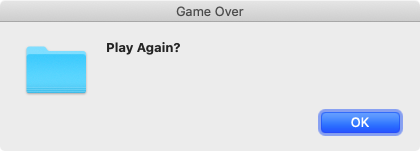
About this logic:
# more code precedes
loop do
time = Time.now
sleep @game.delay
break if @game.game_over? || body_root.disposed?
# ensure entire game tetromino down movement happens as one GUI update event with sync_exec (to avoid flicker/stutter)
sync_exec {
@game.down! unless @game.paused?
}
end
# more code follows
It runs in a separate thread since it has to tick Tetromino movements in parallel to rendering the GUI on the main thread. It relies on a semaphore to ensure no two concurrent games are running at the same time.
It sleeps according to the game rules’ delay (the higher the level, the less sleep there is between Tetromino movements), and then it checks if it has to break if the game is over (or window aka body_root is closed); otherwise, it triggers a @game.down! movement of current Tetromino unless the game is paused.
Block Decoration
The Tetris blocks look a bit bland as border-less labels. How about we improve upon that!?! Let us take advantage of the new Canvas Shape DSL and Custom Shape gems, shall we!?!
There just happens to be the gem to decorate our Tetris blocks with a 3D bevel look that would make it look like an expensive game (not a retro 1997 Linux game, though I loved that era).
Open Gemfile and add the following:
gem 'glimmer-cp-bevel', '~> 0.1.1'
Run the following in the terminal:
bundle
Now, go back to the body {} and replace the label block with the following code:
canvas { |canvas_proxy|
layout_data {
width_hint BLOCK_SIZE
height_hint BLOCK_SIZE
}
bevel(size: BLOCK_SIZE) {
base_color bind(@game.playfield[row][column], :color)
}
}
This results in this new full body {} code:
body {
shell(:no_resize) {
grid_layout
text 'Glimmer Tetris'
composite((:double_buffered unless OS.mac?)) {
grid_layout {
num_columns Model::Game::PLAYFIELD_WIDTH
make_columns_equal_width true
margin_width BLOCK_SIZE
margin_height BLOCK_SIZE
horizontal_spacing 0
vertical_spacing 0
}
Model::Game::PLAYFIELD_HEIGHT.times do |row|
Model::Game::PLAYFIELD_WIDTH.times do |column|
canvas { |canvas_proxy|
layout_data {
width_hint BLOCK_SIZE
height_hint BLOCK_SIZE
}
bevel(size: BLOCK_SIZE) {
base_color bind(@game.playfield[row][column], :color)
}
}
end
end
}
}
Run:
glimmer run
And, wow! What a difference a tiny little Custom Shape Glimmer component made with so little code added.
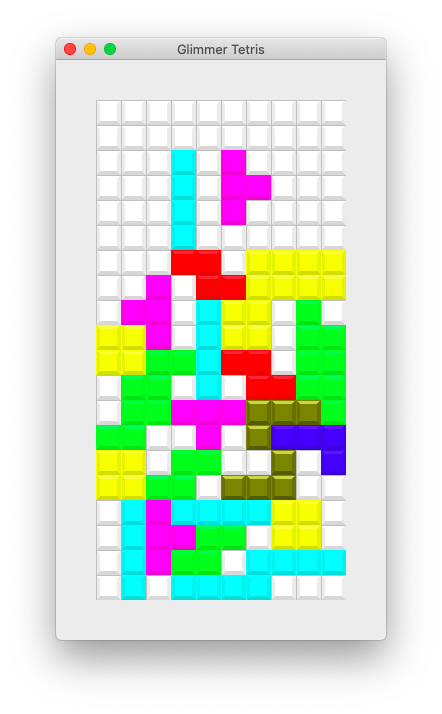
This should conclude this article. Stay tuned for the next article, which will be about Preview Next Tetromino, Score, Lines, and Level as well as some refactorings.
Find Out More
References
- Code :: Glimmer Tetris
- Gem :: Glimmer DSL for SWT
- Blog :: Glimmer Tetris in One Day! and Many More Glimmer Articles
Built with Ruby
(running Jekyll)
on 2023-01-25 18:05:39 +0000 in 0.371 seconds.
Hosted on GitHub Pages.
</> Source on GitHub.
(0) Dedicated to the public domain.